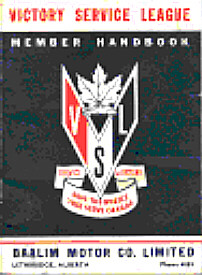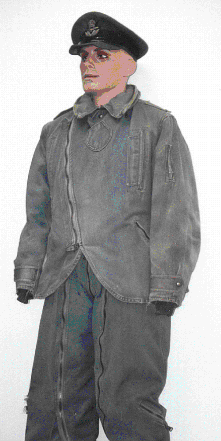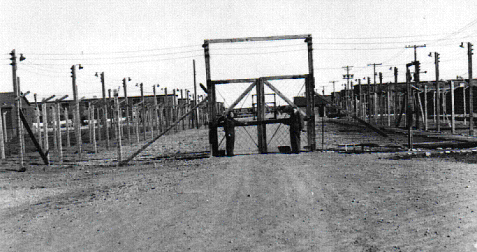
World War II had a great impact on Lethbridge. Citizens of the city provided food and lived with the rationing of important resources for the sake of the war effort. Lethbridge also provided soldiers, sailors, pilots, and gunners for the armed forces. Finally, the city was the site of a pilot training centre and a POW camp.

This is a log book to record the names and contributions of the members of the community who had donated to the War effort.
Because of the rationing everybody in Lethbridge was affected by the war effort. Sugar, canned milk, fruit, tea, coffee, meat, jam, honey, maple syrup, gasoline, and tires were all rationed, while automobiles, household appliances, and radios were almost impossible to get. In addition, voluntary financial contributions to the war effort were provided through the Victory Bond campaigns which earned over $11 million in Lethbridge alone. The sale of War Savings Certificates in the city earned an additional $1 million dollars for the war effort.

P19890035006-GA Five medals from the First and Second World Wars. Includes the Allied War Medal, Volunteer Service Medal, 1939-45 War Medal, Canadian Efficiency Medal, and Canadian Forces Decoration Medal.
A lot of Lethbridge residents were also in active service overseas during World War II. Military units from Lethbridge included the 18th Field Artillery Regiment, the 20th Field Battery, the 55th Light Aide Brigade, the 6th Field Park Company, the 112th Light Anti-Aircraft Battery, the 39th Field Battery, and the 112th Field Battery. The 20th Anti-Tank Battery and the 108th Howitzer Battery were also based at Lethbridge at various times through the war. The women of Lethbridge also served during World War II. Lethbridge women served in the Canadian Auxiliary Territorial Service, the women's division of the R.C.A.F., the Canadian Army Nursing Service, and the Royal Canadian Naval Service.

An instructors uniform from the B.C.A.T.P. The uniform was designed for comfort, warmth, and safety. Loose elbows and knees avoided restricting movements. A warm lining could be buttoned in for poorly heated aircraft, and double zippers would be unlocked with a flick of the wrist if the plane crashed in water. This suit is courtesy of Red Fern from Lethbridge.
Air training was another important way that Lethbridge helped the war effort at home. The Kenyon Field Airport was completed in 1939 and became the site of No. 5 Elementary Flying Training School under the British Commonwealth Air Training Plan.The school trained over 900 pilots and that made the airport a very busy place. The school was moved to High River in June of 1941. Late in 1941, the Royal Canadian Air Force (R.C.A.F.) opened the No. 8 Bombing and Gunnery School at the airport. For some of that time the No.133 Fighter Squadron and the No. 124 Ferry Detachment also trained at Kenyon Field. Throughout World War II Lethbridge was an important training center for the allied war effort.

P19901019001-GP View of Prisoner of War Camp No.133 at Lethbridge, 1940
The largest impact of the war on Lethbridge was the placement of a massive prisoner-of-war camp in the city. Internment Camp No.133 had a capacity of 12 500 POW's and covered 259 hectares in the northeast of the city. The camp was finished in November of 1942 and consisted of six sections with six two-story barracks in each section. The camp received prisoners from November of 1942 until June of 1946. During that time, over 6000 POW's worked on southern Alberta farms for canteen credits, helping to ease the labour shortage caused by the men who were away in military service.

Service Dress jacket, British Commonwealth Air Training Plan, worn by Warrant Officer 2nd Class Litton who was trained at the No. 8 Bombing and Gunnery School in 1942.
One of the most shameful events of the Canadian war effort occurred when Japanese Canadians were evacuated from their homes in British Columbia. When war broke out between Japan and the Western Allies, the largest group of Japanese in Canada lived on the west coast of British Columbia. Race relations between the Japanese Canadians and other British Columbians had been tense for some time. When Pearl Harbor was attacked it gave some members of the mainstream community a reason to remove the Japanese from the coast. Japanese-Canadians were taken from their homes and placed in internment camps in the interior of the province.

Prisoner of War reproduction uniform. The original is located at the Red Deer District Museum and Archives.
At the same time that Japanese-Canadians were being evacuated from the west coast, there was a severe labour shortage in southern Alberta. To help with the war effort, sugar beet producers in southern Alberta were asked to increase their production, but many young men had gone to serve in the military and were unable to work on sugar beet farms. Officials in the sugar beet industry then looked to the Japanese Canadians being evicted from the west coast as a source of labour. A deal was struck between sugar beet producers and the B.C. Security Commission which placed Japanese Canadian families on southern Alberta farms. When the evacuation of the west coast was done, approximately 2250 Japanese Canadians or 370 families had been taken to the Lethbridge area. The Japanese Canadians who arrived in southern Alberta faced difficult working conditions and often found that the farmers with whom they were placed were not prepared to properly house and feed them. At the end of World War II, many of the Japanese evacuees discovered that their property in British Columbia had been taken by the government. Some of them left southern Alberta, but most of them stayed in the Lethbridge area and made new lives for themselves and their families.

Service Dress Uniform worn by pilot Brock Christie during service in the middle east 1939-1945. Uniform courtesy of Brock Christie, Cap courtesy Red Fern.
Previous Page | Exhibit Contents | Home | Navigation Information | Glossary | Curriculum Guide | Next Page
Copyright © 1996 Sir Alexander Galt Museum. All rights reserved.